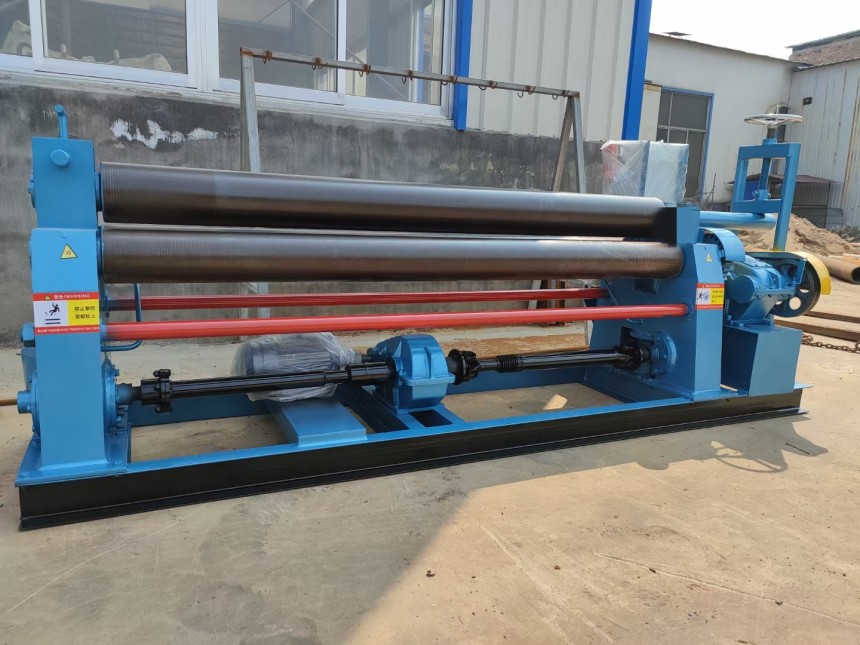

We are a professional manufacturer of plate rolling machine with over 10 years of industry experience. Today, we would like to introduce to you the difference between the process of processing stainless steel and carbon steel by plate rolling machine:

Plate rolling machine as a metal plate forming key equipment, in the processing of different materials need to be targeted to adjust the process. Stainless steel and carbon steel due to differences in material properties, in the process of processing from the equipment parameters, operating procedures to the subsequent processing to distinguish. The following from the actual production point of view to illustrate the core process differences between the two.
1, The influence of material properties on processing
The fundamental difference between stainless steel and carbon steel lies in the composition and mechanical properties. Stainless steel to iron chromium alloy as the basis for adding nickel, molybdenum and other elements, its hardness and ductility is generally higher than ordinary carbon steel. Carbon steel is mainly composed of iron and carbon, divided into low carbon steel, medium carbon steel and high carbon steel, its hardness increases with the carbon content, but generally lower than stainless steel. This difference in properties directly affects the way the plate rolling machine is processed.
2, Differences in equipment parameter settings
Roller pressure adjustment
Stainless steel yield strength is higher (such as 304 stainless steel is about 1.5 times the carbon steel Q235), need to increase the downward pressure of 10% -20%. But too much pressure will lead to surface scratches, need to synchronize with the feed speed adjustment. Carbon steel due to better ductility, standard pressure parameters can be used, but high-carbon steel need to pay attention to rebound compensation.
Bending radius limitation
The minimum bending radius of stainless steel needs to be greater than 1.5 times the thickness of the plate (carbon steel is usually 1 times), otherwise surface cracks are likely to occur. When processing thick plates, it is recommended to use multi-pass progressive bending process.
Roller speed control
Stainless steel processing is recommended to reduce the speed of 30% -40%, to avoid increased plate brittleness due to work hardening. Carbon steel can be adapted to the standard speed, but for the thickness of more than 20mm plate need to be appropriate speed reduction.
3, Key points of the operation process
Pre-treatment of plate
Stainless steel surface should be cleaned to remove oil and dirt, to avoid carbonizing phenomenon at high temperature processing. Carbon steel need to focus on checking the edge burrs, to prevent indentation when rolled.
Lubrication Requirements
Stainless steel must use specialized metalworking fluids (e.g., with chlorine additives) to reduce the coefficient of friction. Carbon steel can use ordinary lubricating grease, but water-based lubricants are recommended for high-precision machining.
Temperature monitoring
Stainless steel continuous processing needs to control the roll temperature does not exceed 120 ℃, to avoid chromium precipitation affect corrosion resistance. Carbon steel is less sensitive to temperature, but medium and high carbon steel need to prevent localized overheating leading to metallurgical changes.
4, Finished product handling differences
Springback correction
Stainless steel rebound is about 15%-20% higher than carbon steel, which needs to be corrected by overbending compensation or calibration process. High-precision processing is recommended to leave 0.5 ° - 1 ° overbend angle.
Surface protection
Stainless steel processing needs to remove the surface lubricant residue, to avoid corrosion of chloride ions. Carbon steel parts are recommended to be rust-proofed within 24 hours.
Equipment maintenance
After processing stainless steel, you need to clean the rollers in time to prevent metal powder from accumulating and accelerating wear. Carbon steel processing focus on checking the flatness of the roll surface.
5, Typical problem response
Stainless steel cracking
Mostly due to the bending radius is not enough or the material itself has inclusions. It is recommended to do a small sample test, austenitic stainless steel can be heated to 150-200 ℃ to improve the plasticity.
Carbon steel size deviation
Mainly from insufficient rebound calculation, can be fine-tuned by test roll 1-2 pieces of parameters. Thickness error of more than 10% of the plate need to recalibrate the equipment.
Common Precautions
When two materials are mixed line production, changing materials need to thoroughly clean the work area to avoid carbon steel chips contamination of stainless steel leading to rust.
Mastery of stainless steel and carbon steel processing differences, the core lies in the understanding of the material characteristics and equipment parameters to match the relationship. The actual production is recommended to establish a classification of operating specifications, through the process card to clarify the key parameters, not only to ensure the quality of processing, but also to extend the life of the equipment. For special grades of materials, specific processing parameters should be obtained from the supplier for advice.
If you are interested in plate rolling machine, please contact us.
 Address:Room 1202, Detaitang Building, No. 118 Huaguang Road, Zhangdian District, Zibo, Shandong
Address:Room 1202, Detaitang Building, No. 118 Huaguang Road, Zhangdian District, Zibo, Shandong WhatsApp:+8615653328535
WhatsApp:+8615653328535 Wechat: +8615965331535
Wechat: +8615965331535  E-mail:zs@sdsmachinery.com
E-mail:zs@sdsmachinery.com